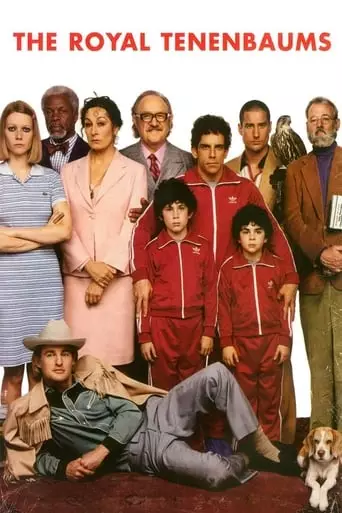Royal Tenenbaum and his wife Etheline had three children and then they separated. All three children are extraordinary — all geniuses. Virtually all memory of the brilliance of the young Tenenbaums was subsequently erased by two decades of betrayal, failure, and disaster. Most of this was generally considered to be their father’s fault. “The Royal Tenenbaums” is the story of the family’s sudden, unexpected reunion one recent winter.
The Royal Tenenbaums is a darkly comedic drama directed by Wes Anderson, featuring a dysfunctional family of once-promising child prodigies, each grappling with their own personal failures and disappointments. The film centers on Royal Tenenbaum (Gene Hackman), an eccentric and estranged father, who reunites with his three adult children in an attempt to reconcile with them and his ex-wife, Etheline (Anjelica Huston). Royal’s reunion with his family comes under false pretenses, as he claims to be terminally ill, hoping to win back their affection.
The story unfolds through a series of flashbacks, which depict the children’s early success and the subsequent unraveling of their lives. Each of the Tenenbaums has a unique and tragic arc: Chas (Ben Stiller), once a brilliant businessman, is now an overprotective father dealing with the trauma of losing his wife; Margot (Gwyneth Paltrow), a once-promising playwright, now lives in secrecy, having abandoned her career and indulging in an affair; and Richie (Luke Wilson), a former tennis prodigy, struggles with unrequited love and depression. Meanwhile, Royal tries to reconnect with them, while also vying for the attention of his ex-wife, who is about to marry another man, Henry (Danny Glover). As their lives collide and Royal’s lies unravel, each member of the family confronts their own shortcomings, fears, and desires for redemption
Themes of the Film
- Family Dysfunction: At its core, The Royal Tenenbaums explores the complexities of familial relationships. The Tenenbaum family is marked by deep emotional wounds, misunderstandings, and estrangement. However, the film also portrays the potential for healing and reconciliation. Through Royal’s actions, the film questions whether it’s ever too late to repair the damage done to a family
- Redemption and Forgiveness: Although each family member is trapped in their own failures, there is a central theme of redemption. Royal’s attempt to reconnect with his children, while flawed, shows his longing for forgiveness. His ultimate death, which occurs in the most ironic and humorous of ways, serves as a bittersweet resolution to his journey of self-improvement
- Failure and the Pressure of Expectations: Each of the children, despite their early brilliance, is haunted by unfulfilled potential and the weight of their father’s neglect. The film suggests that societal and familial expectations can be crushing, leading to feelings of inadequacy, depression, and emotional isolation
- Loneliness and Isolation: A key element in the film is the pervasive sense of loneliness that affects all the characters. While they are surrounded by family, they remain emotionally distant from one another. This isolation is especially poignant for Royal, who, despite his efforts to reconnect, can never fully bridge the gap between himself and his children
Why You Should Watch The Royal Tenenbaums
- Wes Anderson’s Unique Direction: Known for his meticulous style, Anderson’s use of symmetry, color schemes, and quirky visual elements adds depth and charm to the narrative. The film is a visual masterpiece that adds emotional weight to the story
- Ensemble Cast: The film features an all-star cast, including Gene Hackman, Anjelica Huston, Gwyneth Paltrow, Ben Stiller, and Luke Wilson, whose performances are both comedic and deeply moving. Their portrayals of flawed yet relatable characters elevate the film
- Emotional Complexity: Despite its comedic tone, the film explores serious themes like family trauma, loneliness, and redemption, creating a poignant emotional journey. The film’s tragicomic nature allows for moments of humor alongside profound moments of introspection
- Stunning Cinematography: Anderson’s signature use of symmetry and vibrant colors creates a visually captivating experience. Every frame is crafted like a painting, making it a treat for cinephiles and art lovers alike
- Character Development: Each character undergoes significant emotional growth, making their arcs deeply satisfying to watch. Whether it’s Chas learning to let go of his overprotectiveness or Royal’s attempts at reconciliation, the character-driven narrative is compelling
- Dark Humor: The film’s humor is quirky, dark, and often absurd, making it a unique cinematic experience. It finds the comedy in painful situations, making it both tragic and funny at the same time
- Soundtrack: The film features a memorable soundtrack, including songs from artists like Nico, The Rolling Stones, and Elliot Smith, perfectly complementing the film’s tone and atmosphere
- Heartfelt Storytelling: Despite the quirky exterior, the story at its heart is about family, loss, and the possibility of redemption. It invites viewers to reflect on their own relationships and the complexities of familial bonds
- Cult Classic Status: Over the years, The Royal Tenenbaums has become a cult favorite due to its distinct style and the emotional depth of its story. Watching it offers a chance to appreciate a beloved film that resonates with many
- Rewatch Value: The film’s layered storytelling and hidden details make it highly rewatchable. Each viewing uncovers new nuances and insights into the characters’ lives and motivations
What Will You Feel After Watching It?
After watching The Royal Tenenbaums, you will likely experience a mixture of emotions. The film’s bittersweet nature often leaves viewers feeling both uplifted and melancholic. The complex relationships between family members, paired with the theme of redemption, create a poignant conclusion that may make you reflect on your own familial relationships and personal shortcomings. The dark humor and absurdity may also leave you with a sense of catharsis, as the characters’ imperfections are met with acceptance and, at times, love. Ultimately, the film challenges viewers to consider the possibility of healing and the emotional complexity that lies within every family

